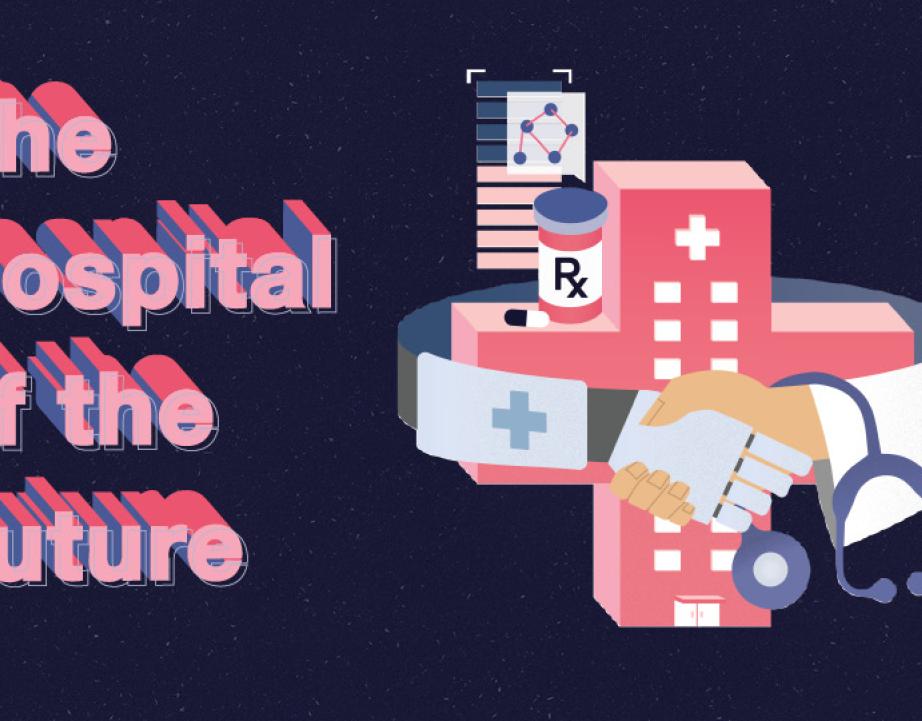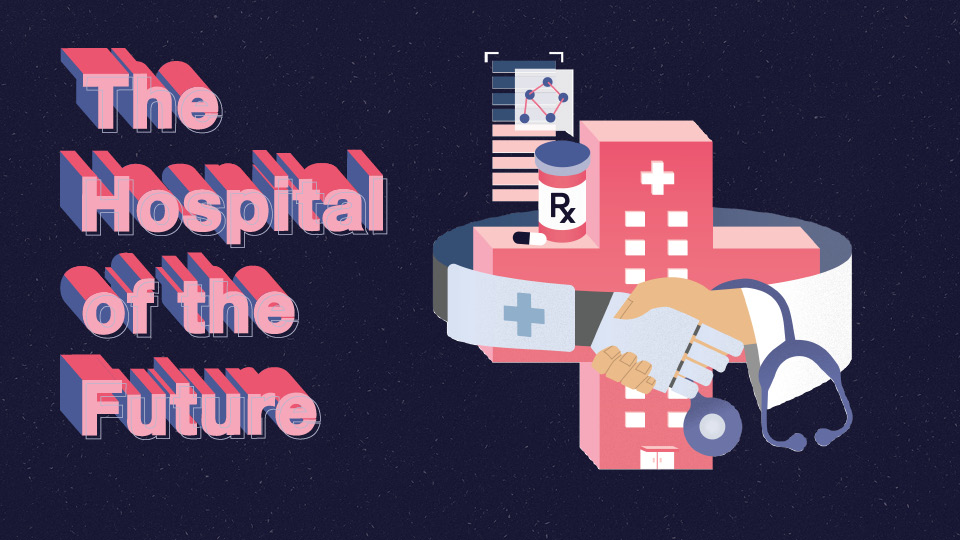by Rachel Stengel '14
In the future, a machine might read your doctor's notes and diagnose your condition. It might also be able to predict when you may suffer a specific medical concern like a heart attack using artificial intelligence. Your care will likely be personalized and based on your DNA. While this may sound like Jetson-era hyperbole, health care has changed dramatically in the past 10 years, and there's no sign of things slowing down.
Barry S. Rabner, a Rider Trustee and the president and CEO of Penn Medicine Princeton Health, cannot predict the future. But in his class "Envisioning and Leading the Hospital of the Future,” he tries to predict what’s most likely to come true by examining what impacts how care is delivered, how those elements are likely to change and then in turn what the health care system will look like. Using the drivers of change he identified, we asked Rider professors and alumni: What does the hospital of the future look like?
Health care costs too much and the industry is trying to change that
The latest numbers show that annually U.S. health care spending equals $10,739 per person or $3.5 trillion. That equates to nearly 18% of the nation's gross domestic product or as Rabner says, "too much for what we are getting."
"On average, other wealthy countries spend about half as much per person on health than the U.S. spends," he says. "We rank No. 1 in health care spending compared to the wealthiest 10 countries in the world and last for affordability, equity and health care outcomes. We ranked next to last for administrative efficiency.
"Estimates predict that the cost of medical care in the U.S. by 2027 could go up to $6 trillion," he says. "There is tremendous economic pressure to deliver care differently. Because it's so expensive, it's gotten the attention of every health care-related company."
Trying to create new models for health care delivery in order to alleviate costs is exactly what Allen J. Karp '81 does. As the executive vice president of health care management and transformation at Horizon Blue Cross and Blue Shield of New Jersey (BCBSNJ), Karp works to move New Jersey from a fee-for-service system toward a value-based system — or in his words, better care for lower costs.
"Essentially, we are changing the way we pay physicians," he says. "In the past, they were reimbursed based on the amount of care given, but that model isn't the best because it doesn't take outcomes into consideration. Now, we pay based on quality of care and whether or not doctors meet certain performance measures. There's an incentive to give patients the best quality care to ensure they have better outcomes, which lowers costs."
For insurance companies, the goal is to set health insurance premiums for subscribers with the intention of paying out less in health insurance claims. With better treatments and more holistic patient care, the insurer can keep rates affordable for patients.
One of the biggest determinants of your health is...your zip code?
With a value-based reimbursement system, health care providers are encouraged to provide care that addresses a person's entire well-being. The ability to have a safe place to call home, access to nutritional food and treatment for mental health concerns are all common social determinants of health that can affect a person's overall well-being.
"It's become very clear in the past 10 to 15 years that your zip code matters more than your genetic code," says Dr. Kristin McCarthy, an assistant professor in Rider's health care management and health administration programs. "When you live in an area where you don't have access to certain things like a local grocery store with fresh produce or you live in an unsafe neighborhood, it all can affect your health negatively."
In one of her classes, the students partnered with a local nonprofit, Trenton Health Team, to map out the food scene in Trenton, N.J., in order to better understand the impoverished city's access to healthy food. Trenton Health Team is a collaborative effort from local hospitals and health care agencies to create a healthier Trenton by addressing many social determinants of health.
"Population health care is not a new concept, but it has certainly gained traction in the past 10 to 15 years with the shift toward value-based health care," McCarthy says. "If you can address some of these social determinants of health, you keep the person out of the hospital. Hospitals save money by not having returning patients, especially when their concerns can be treated so patients have better outcomes."
McCarthy says the true buy-in for a value-based health care system began with the passage of the Affordable Care Act in 2010. The Act included measures that shifted the focus toward population and preventative health care in an effort to reduce costs. The Centers for Medicare & Medicaid Services, the single largest payer for health care in the United States, is also leading the charge for a value-based system.
"You cannot address the cost of health care without focusing on population health needs," McCarthy says. "Data gives us the opportunity to do a better job within a value-based system. Patients are more than the absence of a disease. We need to address these social and economic issues in order to provide better care at lower costs."
Big data creates big impact
Karp is using a similar model to ensure notoriously unhealthy areas receive the services they need. Horizon BCBSNJ ran a pilot program with Robert Wood Johnson Barnabas Health to identify members who were receiving an excess of care.
Upon analyzing claims data, Karp saw certain zip codes were using an upwards of $15 million, which is three to four times what is normally spent on health care. The other, more shocking discovery was that the patients weren't elderly but rather anywhere from 25-40 years old. Using a model developed by the University of Pennsylvania, the team started with analytics to see which areas needed the most attention, then drilled down and identified which blocks to start with.
"The best example is a single mom of three who was suffering from a number of concerns: obesity, depression and diabetes, and she was in the emergency room about two to three times a week complaining of chest pains," Karp says. "She kept being released because they couldn't determine if it was physical or mental. We were able to set her up with a primary care doctor and a clinical social worker. When we tracked her after six months, she hadn't used the ER once and was much healthier."
These types of individual interventions are only possible now because of the ability to harness the power of data. Electronic medical records, as well as insurance claims data, help paint a picture of what health looks like in a certain person or population. Hospitals are taking a similar population health care approach to manage their community's health. Some hospitals are even taking things a step further using predictive analytics to determine when health problems may arise.
"We have access to millions of patient records," says Rabner, who's membership in Penn Medicine's expansive reach includes six hospitals and hundreds of outpatient centers. His hospital, Penn Medicine Princeton Health, even has its own medical informatics department dedicated to collecting and analyzing health care data. "We're using the data in those records to improve clinical care and operational performance, but we can also use predictive analytics. We want to be able to anticipate when a patient will have a problem."
The true potential of data can be actualized through its shared use. That's why patients will notice large hospital systems, like Penn Medicine, dominating the health care scene. With these mammoth health care systems forming, all practitioners within that system have the ability to share patients' health records electronically leading to more efficient and effective care.
The doctor will see you now
With Baby Boomers, the largest generation, aging and requiring more care, the United States will see a shortage of nearly 122,000 physicians by 2032, according to the Association of American Medical Colleges. To address this shortage, health care facilities are relying on physician assistants and nurse practitioners. These providers can offer certain levels of care in collaboration with physicians.
"You can really see this shift first start when people were able to ask their pharmacist a question," says Dr. Daniel Graham '10. "Now with this huge physician shortage, care still needs to be given, but medicine is altering its delivery model. A lot more care is going to be delivered by the mid-level providers like nurse practitioners and physician assistants."
Physician assistants and nurse practitioners are not only populating primary care practices but also urgent care centers like the one Graham works at in Port Monmouth, N.J. Right now, his clinic has about a 50/50 split between doctors and physician assistants or nurse practitioners.
Urgent care centers and minute clinics similarly help address the physician shortage by lessening the burden on hospitals for minor injuries and conditions.
"We can really treat most things that don't require constant vital sign monitoring," Graham says. "Allergies, bone brakes, sprains and minor infections are all really common in our practice. The convenience factor is the main thing for patients. They know for common issues they can come here and get a same-day appointment rather than wait to see their primary care doctor. It allows health care to be much more accessible in communities."
The convenience of urgent care facilities is certainly translating into more usage. The Journal of the American Medical Association says visits to urgent care clinics for insured patients have increased 119% from 2008 to 2015. During the same time, emergency room visits for minor conditions decreased by 36%.
Operating rooms exit the hospital
A joint replacement surgery would have meant at least a three-day stay in the hospital for patients a few years ago. Today, patients don't even need to go to a hospital and can go home the same day. Nearly two-thirds of all operations are performed in outpatient facilities, according to the Centers for Disease Control and Prevention.
Why?
"It's more cost-effective, and technology has expanded so that outpatient or ambulatory care centers have the same capabilities that were once reserved only for hospitals," says Dr. Robert Mignone '07, an otolaryngologist, head and neck surgeon with Penn Medicine. "This is where all surgical specialties are heading."
Mignone performs hundreds of surgeries per year. Most of which are outpatient and some performed in his office. Today, surgeons have helped develop a navigation system based on a scan of the patient's sinuses. They can navigate through the nose during surgery confidently and perform the procedure quicker and safer.
In the past, "You really just relied on anatomy and your experience," he says. "Today, every field has new technology that is helping things get done safer and faster."
Medicine made just for your genetic code
Our genetics tell a unique story. They determine how we look, how our body functions and whether or not we are susceptible to certain health concerns. The international research effort called the Human Genome Project sought to map out the sequence of the human genome and identify the genes that it contains. Or in layman's terms, it allowed scientists to essentially create a blueprint for how to construct a human being.
Upon its successful completion in 2003, medicine has used this blueprint to develop targeted treatments for specific conditions. In certain areas of medicine, like oncology, genetic-based treatments are becoming the norm. “We're beginning to personalize care by looking at an individual's disease and develop a treatment that is specific to their disease process," says Dr. Ryan D. Reber '05, clinical assistant professor of medicine at Sidney Kimmel Medical College of Thomas Jefferson University. "With this approach, we are seeing dramatic improvement in patient outcomes."
The previous approach to treating cancer was to first diagnose the type of cancer, then differentiate it based on the cellular makeup of the cancer to determine what course of treatment to take. Now, doctors can take a look at an even deeper, molecular level of a person's genetics and look for specific proteins on individual cells.
“With lung cancer, for example, treatment was traditionally chemotherapy," says Reber, who is also a pulmonary critical care medicine attending physician and medical director of the intensive care unit at Paoli Hospital in Pennsylvania. "Now, science allows us to take a look at the specific characteristics of each patient's tumor, a deep dive that works to identify the very specific driver mutation that led to that patient’s cancer. With this knowledge, we can attack their mutation and work to inhibit cancer progression. This newer approach began to evolve in the last decade, but in recent years has exploded."


